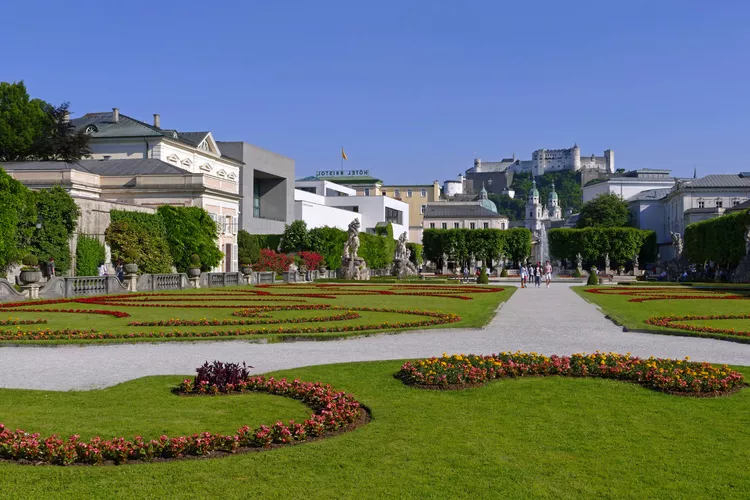Visiting Mirabell Palace in Salzburg
Meta Description: Explore the stunning Mirabell Palace in Salzburg, Austria. Discover its rich history, highlights of the visit, and nearby attractions, all set in beautiful gardens with romantic landscapes.
History of Mirabell Palace
The Mirabell Palace, a stunning architectural gem, dates back to 1606. Constructed by Prince-Archbishop Wolf Dietrich von Raitenau, it was designed to impress his beloved mistress, Salome Alt. Interestingly, the palace was initially called “Altenau,” reflecting its purpose as a romantic sanctuary. However, these joyful family days ended abruptly when Wolf Dietrich was overthrown and died in prison in 1617.
His nephew, Markus Sittikus, found the former love nest unsatisfactory, renaming it “Mirabell,” derived from the Italian words “mirabile” (admirable) and “bella” (beautiful). To erase its scandalous past, he commissioned Baroque architect Lukas von Hildebrandt to remodel it between 1721 and 1727. A devastating fire in April 1818 caused significant damage, destroying many frescoes, yet the magnificent marble staircase and the Marble Hall remarkably survived.
The palace’s neo-classical aesthetics can largely be attributed to court architect Peter de Nobile. Presently, it serves as the office of the Mayor of Salzburg while the Marble Hall is sought after by couples wishing to wed. Furthermore, the inviting gardens offer a tranquil retreat for both locals and tourists.
Highlights of the Visit
The highly admired Marble Hall is undoubtedly the crown jewel of Mirabell Palace. Moreover, the “Donnerstiege” staircase leading to it presents itself as a Baroque treasure with its array of impressive sculptures and paintings.
Historically the banquet hall for the prince-archbishops, the Marble Hall features delightful angel statues and extravagant stucco work. It is revered as one of the most romantic wedding venues worldwide, making advance planning essential for couples aiming to celebrate their nuptials here. Furthermore, Mozart concerts take place almost every night, showcasing the rich musical heritage of the location, as the composer regularly performed here with his sister, Nannerl.
In the southern section, the castle’s chapel has been beautifully remodeled post-1818 fire, featuring a rounded apse, a vaulted ceiling, and dynamic Baroque statues of Saints Augustinus, Rupert, Virgil, and Martin. The altar, dating back to 1722, is the only element to survive the flames.
While the interiors are remarkable, the gardens captivate many visitors even more. Redesigned in 1690 by Johann Ernst von Thun, the Baroque geometric layout is retained. Therefore, don’t forget your camera, as the vibrant gardens provide countless photo opportunities.
The Pegasus Fountain, designed by Austrian artist Kaspar Gras, showcases a stunning sculpture of the iconic horse—perfect for a memorable selfie inspired by the von Trapp style as you explore the gardens.
Additionally, the Rose Garden is known for its romantic ambiance, while the Dwarf Garden, created in 1715, is the oldest of its kind in Europe, featuring 17 dwarf statues inspired by entertainers in service to the archbishop. The Western section includes the Hedge Theater, used for summer performances, and the Orangery, ideal for a cozy retreat during rainy days.
How to Visit
Positioned on the eastern banks of the Salzach River, Mirabell Palace is conveniently within walking distance from Salzburg’s historic center. The entrance to the Mirabell Gardens lies next to the Landestheater (Schwarzsteinstraße 22).
The Marble Hall welcomes visitors from 8 a.m. to 4 p.m. on Mondays, Wednesdays, and Thursdays; and from 1 p.m. to 4 p.m. on Tuesdays and Fridays—apart from wedding days, of course. Additionally, classical concerts occur almost nightly, with tickets starting from 32 euros, so plan accordingly!
The gardens are open daily from 6 a.m. to dusk. Arriving early in the morning or close to closing time is advisable to avoid the crowds. Please note that the Dwarf Garden and the Hedge Theater remain closed during winter.
Entrance to both the palace and gardens is free of charge, making it an accessible and delightful part of your Salzburg experience.
What to Do Nearby
Once you’ve explored Mirabell, many of Salzburg’s top attractions are just a brief walk away. Cross the Salzach River to immerse yourself in the vibrant historic center.
Your first stop should be Salzburg Cathedral, an early Baroque basilica renowned for its striking copper dome and twin spires. Notably, this is where Wolfgang Amadeus Mozart was baptized.
Subsequently, consider hopping on the funicular to Hohensalzburg Castle (or opt for a scenic walk). The fortress delivers breathtaking views and houses three fascinating museums.
To end your day, stroll through Getreidegasse, the celebrated street known for upscale shops and delectable chocolates. Remember to pick up some delicious “Mozart balls” before leaving!





